Freetown flood disaster was ’90 percent man-made’
Three months on, as efforts to repair devastated towns continue, attention turns to how more damage can be prevented.

Freetown, Sierra Leone – Benia Daboh, 31, has been living at a camp with her three children and two nieces since early September.
It is three months to the day since deadly floods and mudslides changed her life.
“I lost my husband, my sister and her husband, now I have to care for their children and my three,” says Benia, who grew up in Freetown, and dreams of working in a restaurant or hotel. “I used to sell fried rice, jollof, potato salad and couscous.”
Benia is not alone.
![Many people were rendered homeless after the mudslides and floods [Lilah Gaafar/Al Jazeera]](/wp-content/uploads/2017/11/c6eecc59f4c74fb6b451c5214c1a2e0a_18.jpeg)
There are hundreds like her, whose families, homes and businesses disappeared in the space of three minutes, when volumes of water, mud and rock swept through Freetown on August 14.
The official death toll from the mudslides and flooding three months ago was around 500 people, but estimates said that it was likely some 1,000 people perished.
I lost my husband, my sister and her husband, now I have to care for their children and my three
It was not the first time Sierra Leoneans witnessed such dramatic events. With annual rainfall of 3,600 litres, natural disasters have plagued the country for years. But previous floods have had less impact.
This time, preventable human causes are being blamed.
The mudslide that devastated the mountain town of Regent was the result of heavy rainfall, urban sprawl and soil erosion due to deforestation.
![Benia Daboh with her children and nieces [Lilah Gaafar/Al Jazeera]](/wp-content/uploads/2017/11/c5c2c9832f3a4c9ab5140e5024b0efed_18.jpeg)
It has also been a catalyst for change.
“This disaster was 90 percent man-made. There were trees along 80 percent of the river and hardly anybody lived there. Thirty years ago, no one would have been killed,” says Thorsten Kallnischkies, a geologist seconded to the United Nations Development Programme (UNDP) office in Sierra Leone.
“The only way to avoid this in future is through raising awareness among the communities – how to build and where to build,” he says. “Administration and government must enforce laws to avoid future fatalities.”
Sierra Leone’s Office of National Security (ONS) has been working closely with national and international stakeholders, says John Rogers, ONS director of disaster risk management.
![A house pictured in Regent, waiting to be repaired [Lilah Gaafar/Al Jazeera]](/wp-content/uploads/2017/11/3513169976ad465a85a86287f8c675c7_18.jpeg)
These include global experts trying to recover losses and withstand future hazards.
In the meantime, government is focusing on restoring water supply; rebuilding bridges; fixing schools, housing; social protection and developing capacity management and early warning systems before next year’s rainy season.
Communities affected by the disaster are also planning and rebuilding their own futures.
Teams of volunteers are cleaning drainage systems, constructing gabions and terraces to protect banks from erosion, and cultivating agriculture through recycling and composting to reduce the erosion of slopes.
And the Environment Protection Agency has put out a radio jingle, proclaiming the impact of human activity on the environment.
“It’s about sensitising communities to risk and enabling them to develop better methods to live,” says the UNDP adviser. “Landslides will always occur as long as there are hills and rainy seasons.”
![The worst damage took place in the mountain town of Regent, on the outskirts of Freetown [Lilah Gaafar/Al Jazeera]](/wp-content/uploads/2017/11/a6bd58b7fcfe4a1a864a386a9654afdf_18.jpeg)
Nonetheless, warns Kallnischkies, unless change takes place at every level, the benefits of development are vulnerable and could be reversed.
“It will happen again, if politicians and administration allow unplanned settlements and deforestation. Victims who lost their families and houses are already rebuilding their houses – in the same places. It’s like having a picnic on a motorway.”
![IDPs wait for pots, pans, soap, foam, rice and oil at the Old Skool camp in Freetown [Lilah Gaafar/Al Jazeera]](/wp-content/uploads/2017/11/f33b59ec598349fb9db6531be895b033_18.jpeg)